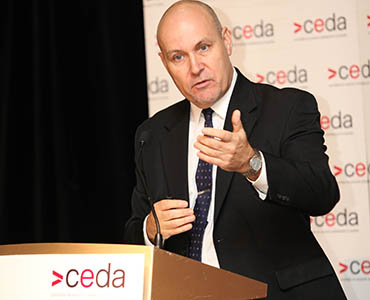The housing price boom in Sydney has entrenched significant barriers to entry to the market and fast tracked the rise of Sydney as the high-rise and renting capital, Domain Group Senior Economist, Dr Andrew Wilson has told a CEDA audience in Sydney.
 Speaking at the annual CEDA NSW property market outlook, Dr Wilson said “any new
Speaking at the annual CEDA NSW property market outlook, Dr Wilson said “any new
policy that constrains the supply of housing in Sydney will only act to increase prices and rents, and exacerbate the looming reality that home ownership is set to become a largely unattainable privilege for most in a city of apartment renters.”
“A first home buyer requires a $120,000 deposit to buy the average first home ‘buyer house’ according to the ABS.
“It’s a big mountain to climb…so unsurprisingly first household buyers are the lowest in NSW.”
Dr Wilson said that unit living and longer-term renting will become the Sydney norm due to reasons including:
- Sydney is geographically challenged with high prices for scarce fringe home allotments;
- Affordability, proximity and amenity advantages and lifestyle choices are driving buyers to living in units;
- Planned housing supply waning but demand is rising from migration driven by the strong NSW economy, including five per cent unemployment rate.
Dr Wilson said home ownership rates will therefore decline long-term in Sydney with permanent renting more prevalent, impacting upon tenants who are searching for long-term security in their tenure.
Dr Wilson also discussed the end of the housing boom in Sydney.
“The Sydney boom has ended maybe with a hiss and not a pop,” he said.
“Prices this year have fallen by 1.5 per cent.
“Typically, when we see prices falling through the phases it’s because of a driver – either higher interest rates or lower incomes, higher unemployment.
“This time it’s just a waning of the energy that we’ve created over the past three years.”
Also speaking at the event was Grocon Executive Chairman, Daniel Grollo who discussed commercial real estate.
Mr Grollo said that while rental fundamentals had been irregular, from an investment perspective it was largely the opposite, with consistent tight yield and compression and continued and increased capital flows being attracted to Australia in the commercial office sector.
“That’s the big story in my view. Asian and in particular Chinese capital flows into the Australian property market,” he said.
“If you stepped back and look at outbound property flows in 2015 from China into global property markets, Australia ranked number two only just behind the US.
“These flows are growing fast…(they) have almost doubled over the last three to four years and is set to continue over the next 10-20 years.”
Commonwealth Bank Managing Director and Global Head of Real Estate, Graeme Ross, discussed offshore buyers of commercial real estate, which has moved from 31 per cent in 2013 to 52 per cent in 2015.
“We are the flavour of the month,” he said.
“We’ve talked at this forum in previous years about what has driven this activity: it’s transparency of the market, it’s the yield arbitrage, it’s solid and predictable planning regimes although many people may not necessarily agree with that but it does underpin value and quality of tenants and markets here.”